Structure and Function of extracellular matrix (cell wall) | Botany Optional for UPSC PDF Download
| Table of contents |

|
| Introduction |

|
| Bacterial Cell Walls |

|
| Plant Cell Walls |

|
| Extracellular Matrix |

|
Introduction
The boundaries of cells are predominantly defined by the plasma membrane, serving as a protective barrier separating the cell's interior from the external environment. However, many types of cells are enveloped by an insoluble array of secreted macromolecules, creating a complex structure known as the extracellular matrix. In addition to this, certain cells, such as those of bacteria, fungi, algae, and higher plants, possess rigid cell walls that are an integral part of their architecture. These cell walls and the extracellular matrix play critical roles in maintaining cell integrity, regulating cellular behavior, and providing structural support to cells and tissues.
Bacterial Cell Walls
Gram-Negative and Gram-Positive Distinction
Bacterial cells exhibit a remarkable diversity in their cell wall structures, primarily classified into two broad categories discerned through a staining procedure called the Gram stain, developed by Christian Gram in 1884. This distinction separates bacteria into Gram-negative, typified by organisms like E. coli, and Gram-positive, represented by the common human pathogen Staphylococcus aureus. Gram-negative bacteria possess a dual membrane system, comprising an inner plasma membrane surrounded by an outer permeable membrane. Thin cell walls are situated between these membranes. In contrast, Gram-positive bacteria have a single plasma membrane enveloped by a much thicker cell wall.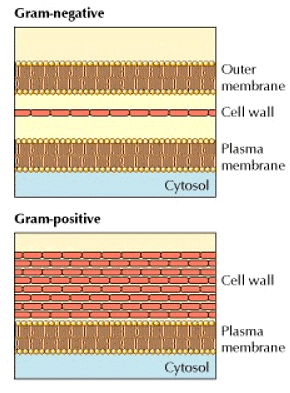
The Role of Peptidoglycan
Both Gram-negative and Gram-positive bacteria share a common component in their cell walls, which is peptidoglycan. Peptidoglycan is composed of linear polysaccharide chains crosslinked by short peptides. This crosslinked structure forms a robust covalent shell around bacterial cells, offering protection and structural integrity. Interestingly, this unique cell wall structure makes bacteria susceptible to certain antibiotics. For example, penicillin inhibits the enzyme responsible for cross-linking peptidoglycan strands, hindering cell wall synthesis and bacterial growth.
Plant Cell Walls
Composition and Structure
Unlike bacteria, eukaryotic cells, including those of fungi, algae, and higher plants, have cell walls principally composed of polysaccharides. Fungal cell walls, for instance, are primarily constituted of chitin, while most algae and higher plants rely on cellulose, the most abundant polymer on Earth. Cellulose is a linear polymer of glucose residues linked by β(1→4) glycosidic bonds, forming long, straight chains. These chains associate in parallel to create cellulose microfibrils, imparting mechanical strength to plant cell walls. Additionally, plant cell walls contain pectins, branched polysaccharides with numerous negatively charged galacturonic acid residues, capable of forming gels by binding positively charged ions and water molecules.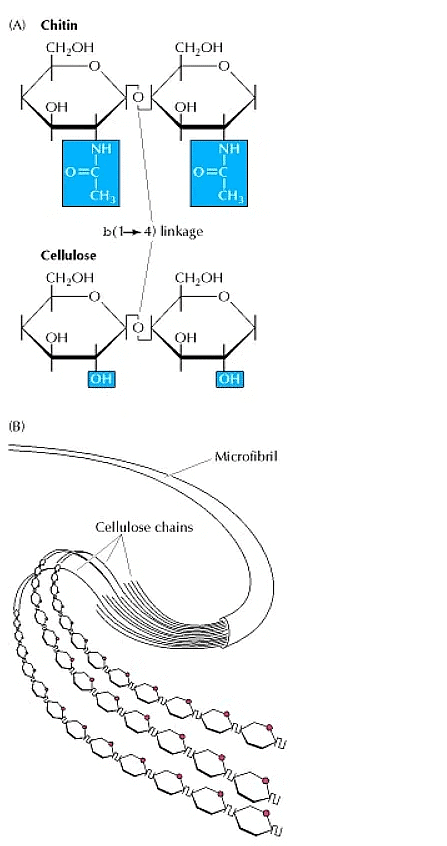 Polysaccharides of fungal and plant cell walls
Polysaccharides of fungal and plant cell walls
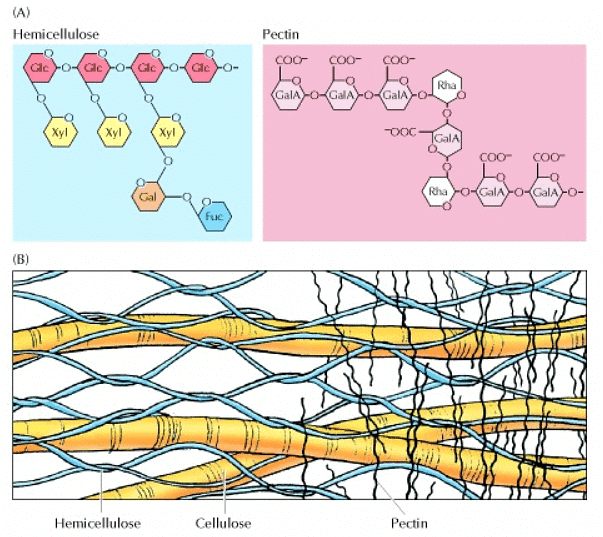 Model of a plant cell wall
Model of a plant cell wall
Developmental Changes in Cell Walls
The structure and function of plant cell walls undergo transformations during cell development. Primary cell walls of growing plant cells are thin and flexible, facilitating cell expansion. As cell growth ceases, secondary cell walls, thicker and more rigid than primary walls, are deposited between the plasma membrane and primary cell walls. These secondary walls are characterized by a higher cellulose content and may also incorporate lignin, a complex polymer conferring strength and density to wood.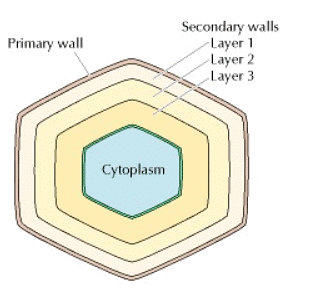
Role of Turgor Pressure
Plant cells are unique in their ability to tolerate osmotic pressure-driven water influx due to their rigid cell walls, preventing swelling and bursting. Instead, turgor pressure, an internal hydrostatic pressure, builds up, counteracting osmotic pressure and regulating water uptake. Turgor pressure contributes significantly to the rigidity of plant tissues.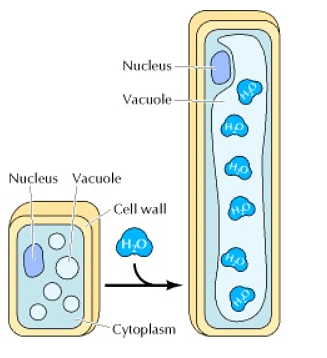
Cellulose Synthesis and Cell Expansion
Cellulose synthesis during cell elongation is orchestrated by cortical microtubules underlying the plasma membrane, determining cell wall growth direction, cell expansion, and plant shape.
Extracellular Matrix
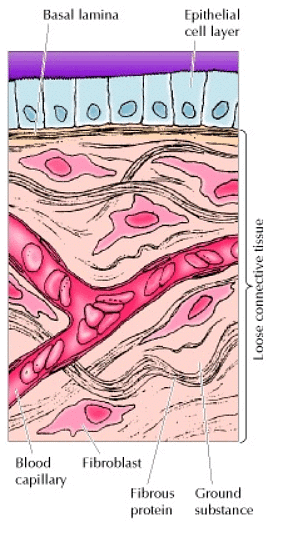
Diverse Roles in Animal Tissues
In animal cells, extracellular matrix (ECM) serves crucial functions. ECM exists in various forms, including the basal laminae that support epithelial cells, muscle cells, adipose cells, peripheral nerves, and connective tissues. ECM, akin to plant cell walls, comprises fibrous structural proteins embedded in a gel-like polysaccharide ground substance.
Proteins and Polysaccharides
ECM components encompass fibrous proteins, polysaccharides, and adhesion proteins that interconnect matrix components and associated cells. The central fibrous protein in ECM is collagen, representing the most abundant protein in animal tissues. Collagen forms triple helices and assembles into collagen fibrils, which contribute to tissue strength and resilience. Additionally, there are other types of collagens, including fibril-associated and anchoring collagens, each with distinct roles in the ECM.
Glycosaminoglycans (GAGs) and Proteoglycans
GAGs, composed of repeating disaccharide units, are combined with proteins to form proteoglycans, which can constitute up to 95% of their weight. These macromolecules interact with collagen, other matrix proteins, and each other to create gel-like networks within the ECM. Hyaluronan, a unique GAG, exists as a single, long polysaccharide chain and contributes to large aggregates within the collagen network.
Fibronectin and Laminin
Fibronectin, another ECM protein, forms crosslinked fibrils and binds to collagen and GAGs. Laminin, on the other hand, is crucial for basal laminae and associates with type IV collagen, perlecan, and entactin, creating intricate crosslinked networks.
Integrins and Cell-Matrix Interactions
Cell-matrix interactions are mediated by integrins, transmembrane receptors with binding sites for various ECM components. These interactions establish the stability of cell-matrix junctions, including focal adhesions and hemidesmosomes, ensuring cellular attachment and functionality.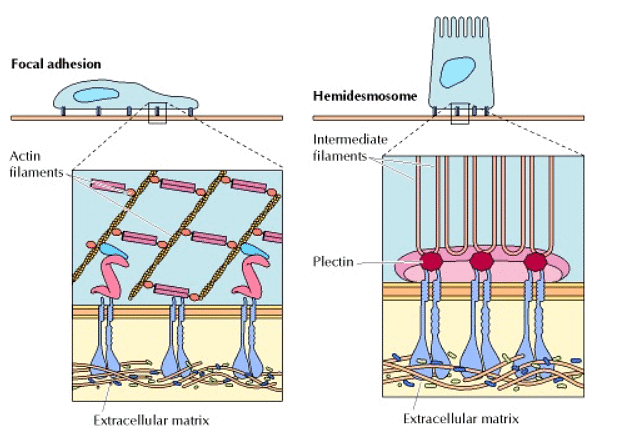
In conclusion, cell walls in bacteria and plant cells, along with the diverse components of the extracellular matrix in animal tissues, are pivotal in maintaining cell integrity, regulating cell behavior, and providing structural support in multicellular organisms. Understanding these intricate structures enhances our comprehension of cellular biology and tissue function.
|
179 videos|143 docs
|
FAQs on Structure and Function of extracellular matrix (cell wall) - Botany Optional for UPSC
| 1. What is the function of the bacterial cell wall? |  |
| 2. How is the plant cell wall different from the bacterial cell wall? |  |
| 3. What is the role of the extracellular matrix in animal cells? |  |
| 4. How does the extracellular matrix contribute to tissue regeneration? |  |
| 5. Can the composition of the extracellular matrix influence cell behavior? |  |














